You, my friend, are about to learn about one of the greatest aspects of Japanese culture. It's cute, fluffy, magical, and ridiculous. And it has giant testicles which it uses to perform amazing feats. Meet the tanuki.
Tanukis and foxes are similar at first glance. They're both smallish, wild canines native to Japan. They are both adaptable and successful over a wide range of habitats, including cities. If you read Japanese folklore, you'll see they both have shapeshifting powers which they use to deceive people. They're so similar, they can even be spoken of as a kind of unit using the jukugo word kori 狐狸, made up of the kanji for tanuki 狸 and kitsune 狐.
But tanuki and foxes also have many differences. The fox is familiar throughout the world and appears in the mythology of many countries. But the tanuki is unique to Japan. Westerners who first encountered the tanuki and tanuki folklore totally mangled the translation of its name. To this day, most Westerners have never heard of it.
If you still feel lost, we made a video to bring you up to speed in under 7 minutes:
While the kitsune has maintained an aura of danger and awe, the magical tanuki has become the kind of character you'd love having a cup of sake with. He's a mischief-maker and prankster, down-to-earth, and downright bawdy. When we get to the part about his magical balls, don't say I didn't warn you.
- Tanuki Shapeshifting
- More Tanuki Trickery
- Tanuki Illusions
- Tanuki Balls
- The Tanuki Adapts to Modern Times
- The Real-Life Tanuki
- What Isn't a Tanuki?
- Tanuki Today
Tanuki Shapeshifting
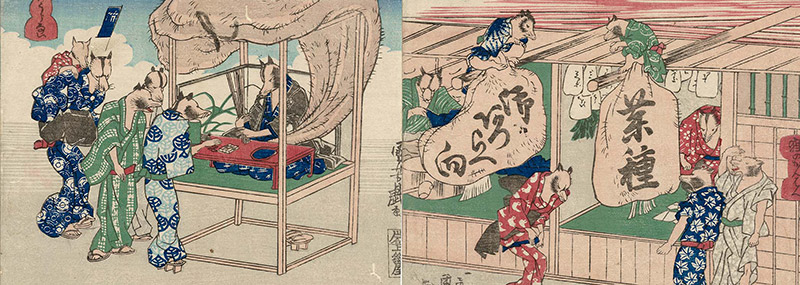
Both the fox and the tanuki can fool you into thinking they're human. But each has a different favorite disguise. There are stories of tanuki doing the classic kitsune illusion, pretending they're a beautiful woman and seducing a man who wakes up the next morning in a pile of leaves in the middle of the woods. But the tanuki's favorite disguise is that of a Buddhist monk. So much so there's a name for the tanuki disguised this way: tanuki-bōzu 狸坊主.
Like the kitsune's connection with Shinto, an association with Buddhism runs through the tanuki mythology. But his relationship to the religion is different. It's more a kind of sardonic commentary. When tanuki-bōzu is seen in art, he's always well-nourished and comfortable-looking. No Zen asceticism for this guy.
Tanuki also enjoy gathering together to imitate human activities. These include Buddhist rituals like funerals. They assemble in graveyards at night with lanterns, imitating chants. Tanuki-bōzu even copy that most human of activities, writing. Our friend Zack Davisson translated one of these tales:
The tanuki claimed to be a monk from the Murasaki Otoku temple in Kyoto, and was under a vow of silence so could only communicate by written notes.
Now, the handwriting of this monk was most peculiar. He freely mixed the styles of artful Chinese calligraphy and machine-printed Japanese with some strange flourishes that Heigo had never seen before. There were many grammatical mistakes as well, and Heigo thought it looked like the sort of thing that a tanuki would write.
There are many such stories of tanuki writings that have been passed down through the years.
Tanuki seem to enjoy imitating the self-important figures of human society in general. They're also said to impersonate government officials. They'll knock on your door, harassing you into pay your taxes. Or they'll accuse you of some imaginary infraction of the law.
If you suspect you're being pestered by a tanuki in disguise, the clues will be the same as for kitsune.
They may be somewhat luminous when transformed. If it rains, their kimono will stay dry. Look for the tail. If a tanuki loses focus on maintaining their illusion, their tail will pop out.
More Tanuki Trickery
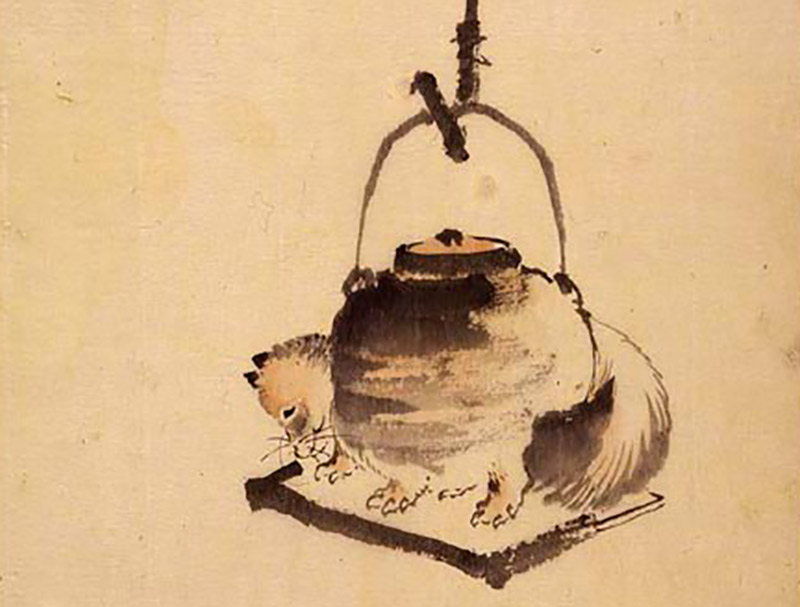
Tanuki love to shapeshift into objects too. They can disguise themselves as trees, stone lanterns, and even the moon. They love to do the moon trick when the moon is out. It makes people think they've gone crazy.
The classic tale of tanuki-as-object is Bunbuku Chagama. There are many variations but here's one version:
A farmer rescues a tanuki from a trap and, in gratitude, it transforms into a teapot that he can sell to get money as a thanks for the favor. When the buyer uses his new purchase, the tanuki can't stand the heat, so the kettle sprouts a head and legs and tail and runs away. That last irresistible image is often depicted in works of art like prints and netsuke.
Tanuki also enjoy making noise. Some of which doesn't involve any magic, which proves how much they love mischief. They frighten people at night by throwing stones at their house. They drop buckets into wells. They clatter pots and pans. Throwing a continuous rain of pebbles onto the roof of a house is another favorite. Drumming on their big bellies is something tanuki are famous for. In the woods, they use this sound to draw people off the beaten path until they're lost.
Tanuki can also imitate sounds. This makes people think they're hearing thunder and lightning, for example. The tanuki's love of mimicry turned perilous during the Meiji period. Japan opened to the West in the late nineteenth century and started to develop technologically. In one example, a train conductor hears a train whistle and the "shu shu po po po" sound of another steam engine coming straight towards him. In those early days there was only one track shared by trains going in both directions. So the conductor stops in a panic to avoid a collision.
But no train ever arrives…
It happens again and again till one night, the conductor decides to keep going. And nothing happens. The next morning, he finds a dead tanuki on the tracks. "Well, of course, it was just that tanuki enjoy imitating things," the narrator concludes.
Some see this tale as an allegory of the clash between the new and the traditional. Between foreign introduction and native Japanese culture. The train was a powerful symbol of Westernization. On the other hand, real dead tanuki were found on train tracks all the time, so who's to say it was only a legend?
Tanuki Illusions
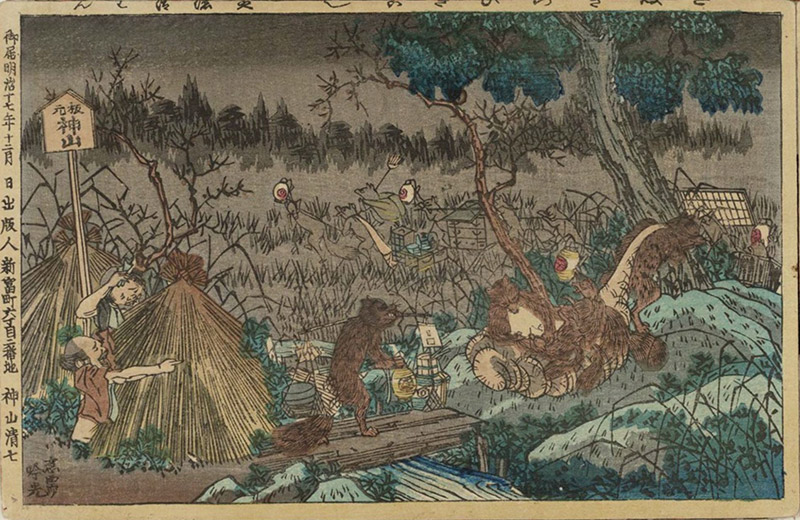
Tanuki can produce a host of other illusions as well. They'll often buy things with money which later turns to leaves (after they're long gone of course). They can make people see entirely different landscapes, causing them to get lost even in familiar territory. They can produce will o' the wisp fire, like kitsune. They use this fire to prank people, naturally. Before artificial light, this was a good way to fool a farmer into thinking he was having a whole conversation with a fellow smoking a pipe in the dark. And they think it's a hoot to make fisherman's nets feel heavy with fish and watch as they pull up empty nets.
Tanuki can also get kind of meta about this stuff. There's one legend of a tanuki who tricks a man into thinking he's watching a tanuki transformed into a shamisen player. The man thinks he's got it all figured out. He knows the shamisen player's tanuki identity and he plans to reveal it to the gathered crowd. Just as he's about to expose the incognito tanuki, the man realizes he's actually looking at a horse's ass.
In a story by the renowned Meiji-era novelist Natsume Sōseki, a character is reading a book written by a tanuki. The tanuki author bemoans the fact that people have such contempt for his species. While there is "such a commotion about Western this and Western that." Why make such a big deal out of this new Western import, hypnotism, he laments, when tanuki have been doing the same thing for centuries?
Tanuki Balls

The legendary tanuki clearly has a lot of interesting characteristics. But there's no doubt which is the most strange and unique: his magical expanding scrotum.
Yes, really. It's said the tanuki can stretch his ball sack to the size of eight tatami mats. Of course it's more flexible than tatami, so it's way more useful. Tanuki are depicted using their nutbags as sails for boats, fishing nets, umbrellas, swimming pools, cloaks to smother an enemy…
"Depicted" seems to be the important word here. The amazing scrotum is big in art. But not so much in the stories. It's a later addition to the tanuki's repertoire. The tanuki balls craze took off in the Edo period when ukiyo-e artists went wild illustrating it. Zack Davisson, who's read lots of Edo-period stories about tanuki, says they mostly focus on their shapeshifting or belly-drumming, not the magical scrotum. The tanuki balls seems to make a better visual than a plot element.
How did tanuki come by this unique magic? It's got nothing to do with sexual prowess (this is never a feature of tanuki legends). The generally accepted explanation is a lot less fun for the tanuki. In the old days, metal workers in Kanazawa would wrap gold in the skin of tanuki testicles when making gold leaf. You want to hammer your gold to the thinnest sheet possible. So you need a skin that can stretch a long way without breaking. It was said a tanuki scrotum could reach the size of eight tatami.
What clinched it, though, was probably the pun: kin no tama "small ball of gold" and kintama, slang for testicles. Tanuki scrotums began to be sold as wallets and lucky charms, said to stretch your money the way they stretched the gold.
It's worth mentioning here Japanese culture is a lot less uptight about this sort of body-part humor than the West. For example there's a traditional children's song about it, which begins:
Tan Tan Tanuki no kintama wa,
Kaze mo nai no ni,
Bura bura
Which is this in English:
Tan-tan-tanuki's balls,
even if the wind isn't blowing
swing, swing.
Here's a video of a Japanese guy singing the song, if you want to learn the tune yourself:
Wikipedia claims the tune this is sung to is the same as the gospel song "Shall we gather at the river?" It kind of sounds like it a little. But even after listening to both over and over, it's not clear whether these two songs are related.
I've always wondered what the female tanuki's take is on all this. I've been unable to dig anything up on the subject. Even if the size of their sack gave tanuki some advantage in the sack, they seem far too busy creating sails and nets and carpets to tend to the ladies. I'm still looking for an ukiyo-e print with a female tanuki standing off to the side rolling her eyes at the foolishness.
In any case, it's pretty clear, if you're female and want to be a Japanese mythical canine, you'd be better off as a kitsune. When it comes to tanuki, males get to have all the wacky fun.
The Tanuki Adapts to Modern Times
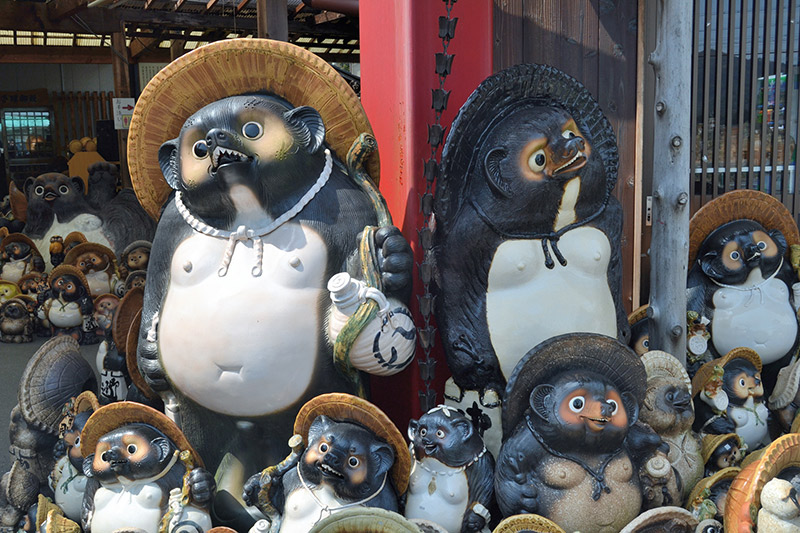
Though tanuki are pranksters and sometimes even frightening, they've always had a good side. Or at least, if you scratch their back they'll scratch yours.
There are stories like the Bunbuku Chagama. In it the farmer who helps the tanuki is rewarded.
There's another story where a homeowner awakens to find a tanuki family devouring the remains of a feast. He takes pity on them and begins leaving food out every night. One night, burglars break in. Fortunately two gigantic wrestlers appear to drive them away. The family bows in thanks. But when they stand up, they find their rescuers had vanished. Later the tanuki appear in a dream and explain the wrestlers had been them in disguise.
If you want to get tanuki on your side, do it with food. They are said to love fish and "parched beans." The dish called tanuki soba isn't called that because tanuki like it. It's probably because the crunchy batter bits sprinkled on top don't contain anything. So they're kind of a tempura illusion.
Nowadays, the most common manifestation of the tanuki is entirely positive. It's that cute statue with a round belly, straw hat, and big eyes. You'll usually see it outside shops and restaurants. This depiction is actually a 20th-century development. And it's generally attributed to one person: Fujiwara Tetsuzō. He was ta potter of Shigaraki-yaki, a type of ceramics made in Shiga Prefecture. This is where most mass-produced tanuki statues come from. This includes odd ones catering to modern tastes (tanuki baseball player with huge balls, anyone?).
The story goes, Emperor Hirohito made a visit to the town of Koga in 1951. Koga is the center of ceramic production in Shiga. So naturally the street was lined with flag-waving tanuki statues to honor his visit. The Emperor was so tickled that he wrote a poem about the tanuki. The statues took off in popularity after this celebrity endorsement.
The modern tanuki popularized by the statue is said to be a symbol of eight boring virtues. The tanuki is now a kind of commercial good-luck figure. It's a little sad. This creature who would fool people into thinking it was an entire train. It battled the forces of modernity and change! But now it's reduced to attracting restaurant customers. I guess we all have to adapt to the times. The train always won in those stories, after all.
The Real-Life Tanuki

The 20th-century changes brought us a long way from the real wild animal. The famous tanuki statue doesn't look much like a real tanuki. This often happens when animals get transformed into folkloric characters. A teddy bear doesn't look much like a grizzly, either.
In real life, tanuki have much pointier snouts. They look more like fluffy brown foxes (If looking at this picture has you considering a tanuki pet, I don't blame you). Their fluffy coat is one of the reasons the species lives all over the world. Tanuki are originally native to the far East, from China, Japan, Korea to Mongolia and the far southeast of Russia. But beginning in the 1930s, Russians introduced tanuki into the wild so they could be hunted for their fur. Now they're found all over Europe. By 2005 they were sighted in northern Italy. Tanuki had managed to cross the Alps. In some places, like Finland, they're now the most common medium-sized carnivore. Their fur is still used commercially, including in Japan, where it's used for calligraphy brushes.
The tanuki was so successful when introduced to new places because it's adaptable. It can survive far north because it's the only canid that can hibernate. They have a varied diet, eating anything they can catch as well as non-meat items like berries. They can travel a long way looking for a suitable habitat, And they have larger litters than similar sized carnivores (up to 8-10 pups at a time).
They're clearly invasive by definition. But scientists have found little evidence that they have a negative impact on native fauna. However they can carry diseases and some nasty parasites.
Tanuki are so adaptable they can also live in cities. This is actually better for them in some ways than rural areas. Less competition from stray dogs, and way more human leftovers. In fact it's estimated about a thousand tanuki live in Tokyo. Some live in relatively foresty bits of the city. They're often sighted around Meiji Jingu shrine and are reported to live in the Imperial Palace grounds. But they're also seen in totally unnatural areas. There's this one on the subway and this one that was running around in Akihabara. My favorite story is the tanuki a couple of years ago that strolled into a ballet studio in Ebisu, aided by an automatic door.
The woman at the reception of the ballet class said, "The automatic door in front of me opened, even though there was no sign of anyone passing by. I thought it was strange, then I heard a scream, and when I went into the back classroom, I was surprised to see a raccoon dog. "
Three police officers responded. By the time they arrived, the tanuki was having second thoughts about studying dance. It reportedly "calmly approached the net that the police officer was holding."
What Isn't a Tanuki?
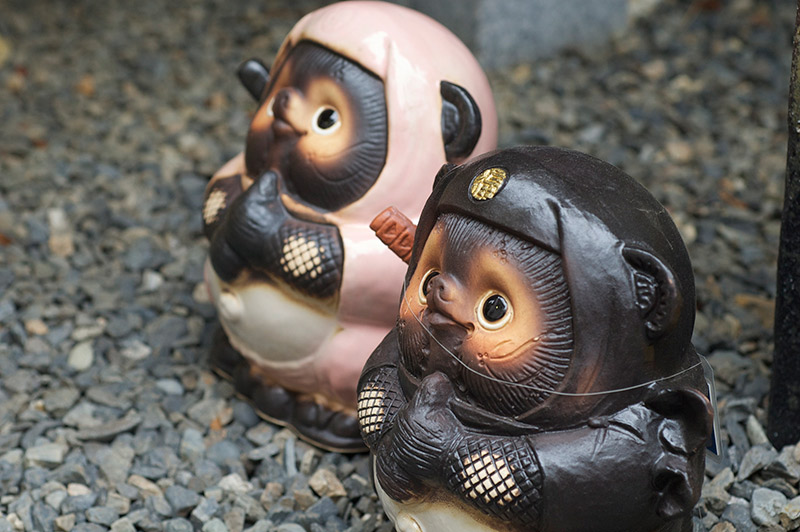
When Westerners began writing about Japan in the nineteenth century, there was no English word for tanuki. So the situation began in confusion. And it has stayed that way to this day.
Folklore scholars called it a badger. This seems pretty inexcusable since the animals aren't even vaguely related. Their only real similarity is they have black marks on their face. By that token, they could have called it a panda. They also seem to have ignored the fact that the word for "badger" is actually anaguma.
To be fair, they were probably confused. There was ambiguity in the traditional Japanese nomenclature for various unrelated creatures. The tanuki had other local names including mujina and mami. The word mujina was also used to refer to all kinds of medium-sized wild mammals including the badger. Apparently some people even took advantage of this, as is written about at Onmark Productions:
This confusion is sometimes the source of great amusement. In Tochigi Prefecture, for example, the Tanuki is called "Mujina." In 1924, in the so-called Tanuki-Mujina Incident たぬき・むじな 事件, Tochigi authorities prohibited the hunting of Tanuki and promptly arrested one hunter — who claimed he was out hunting mujina. The man was taken to trial, but eventually acquitted (on 9 June 1925). His defense argued that hunting of "mujina" was not prohibited by law, that the hunter's intention was to pursue mujina, and therefore, by law, he was not guilty of any offense.
In English the real animal is now generally called "raccoon-dog." But if you read 20th-century English writings on folklore, you'll still see tanuki referred to as "badgers."
Tanuki had one big chance to be introduced to American audiences properly. Sadly it was mixed up with another animal instead. The Studio Ghibli movie Pom Poko is about tanuki in suburban Tokyo trying to save their habitat from developers. As I've ranted about elsewhere, the English version of the movie calls the tanuki "raccoons." Not raccoon-dogs, but raccoons. Another medium-sized, unrelated mammal from another part of the world.
The substitution no doubt seemed like an easy out. As cartoon characters at least, both animals are chubby, masked, and have similar rascally personalities. I guess they hoped kids wouldn't be able to figure out what was going on in those magical-ballsack scenes, something which is not a feature of raccoon lore in the West.
Personally, I don't get it. When the movie Madagascar came out, I bet most kids didn't know what a lemur was. But it didn't cause widespread childhood trauma. Maybe the tanuki are okay with this. Maybe they like being translated incorrectly. It's another kind of shapeshifting, after all. And maybe it's nice to be able to remain a bit mysterious at least in some parts of the world, instead of being forced to stand in front of shops smiling and wearing a straw hat.
Tanuki Today

The tanuki still play a lively role in Japanese culture. Once you start looking for tanuki in Japan, you'll see representations of them everywhere. Even aside from the ubiquitous statues. I particularly love the informational stickers on the Tokyo metro, like the one above. The tanuki is mascot for many companies, playing his cute commercial good-luck role. For example the Lawson convenience store points card has Ponta. And as tanuki are a symbol of the hip Hachijoji neighbohoood of Tokyo.
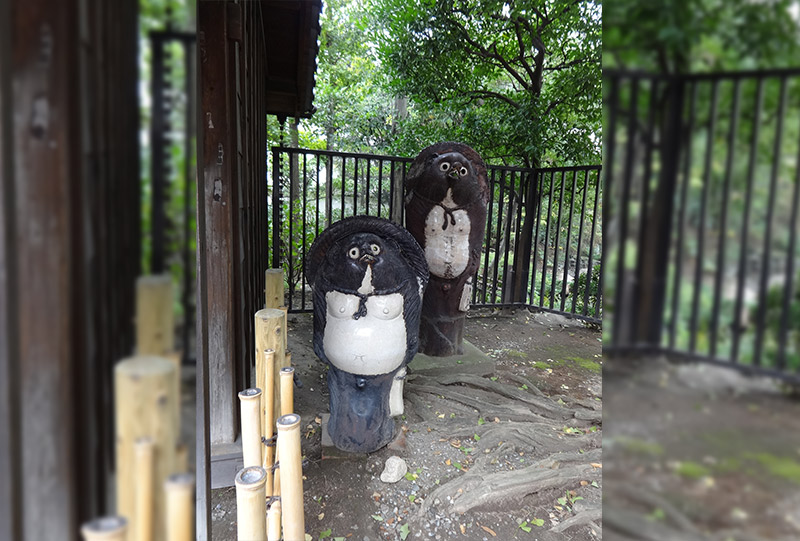
If you want to have a more old-school tanuki encounter, visit a couple of major tourist attractions in Tokyo. There's a shrine to tanuki in Akihabara that goes back to the late 17th century. There's Chingodo Shrine at Sensoji Temple in Asakusa. It has got a couple of big tanuki statues and puts on a festival every year on March 17th. There seem to be conflicting stories about the origin of Chingodo Shrine. The story on the temple's website goes like this: in the late 19th century, the head priest of Sensoji had a dream. In it the tanuki living in the garden of his official residence were its guardians. And so a shrine was built to honor them. The English sign at the shrine itself, though, says the deity was enshrined "to prevent mischief by raccoon dogs that had taken up residence."
Either way, sounds like a good deal for the tanuki. Since there was a dream involved, I've got a pretty good idea of where it came from.
